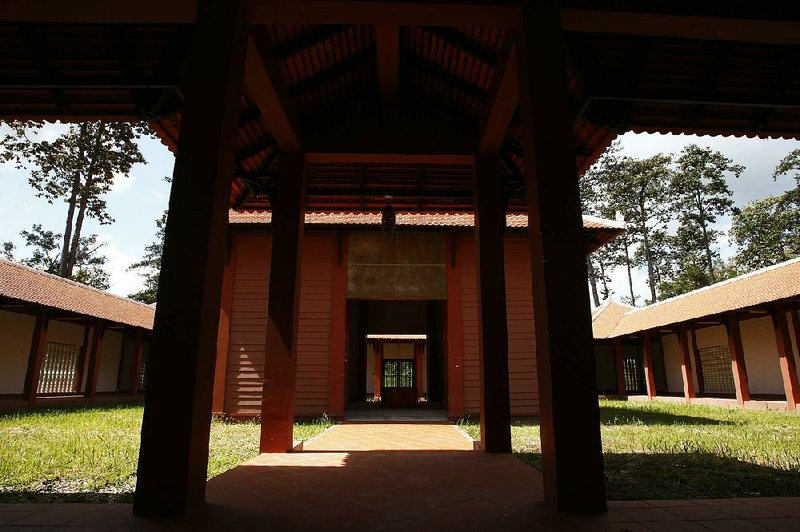PREAH VIHEAR PROVINCE, Cambodia - Rising out of the jungle on white pillars, the new Preah Vihear Museum’s largest building stands empty. But Cambodian officials hope that one day it will be the place where nine ancient statues depicting a dramatic battle scene are reunited from around the world.
They drew a step closer to that goal last week, when Sotheby’s auction house in New York agreed to return one of the statues to Cambodia, ending a legal battle that began when the U.S. government filed a lawsuit last year at Cambodia’s initiative to press for the statue’s return.
The decision marks the latest progress in efforts to reunite the nine figures that once formed a tableau in a tower of the 1,000-year-old Prasat Chen temple. The scene captured a famous duel in Hindu mythology in which the warrior Duryodhana is struck down by his cousin Bhima at the end of a bloody war of succession while seven attendants look on.
Experts said looters hacked the life-size sandstone figures off their bases during the country’s brutal civil war in the early 1970s. Some of the statues apparently were smuggled out of the country and eventually wound up in the hands of private collectors or in museums abroad, as did many statues from other temples that the Cambodian government now hopes to reclaim.
The footless figure of Duryodhana, valued at $2 million-$3 million, was placed in Sotheby’s auction catalog in 2011 after the widow of its private Belgian owner gave it up for sale.
Discussions are now underway between the Cambodian government and the Norton Simon Museum in Pasadena, Calif., about the possibility of returning the statue of Bhima, which has been on display there for more than 30 years.
“The spirits of the Khmer ancestors are not at peace when they see artifacts that were either looted or being commercialized, so we hope that others will follow the very good example of what Sotheby’s has done,” said Ek Tha, a government spokesman.
The figures of three onlookers to the duel are now in Cambodia, including two that were returned in June by New York’s Metropolitan Museum of Art. The remaining four are still missing.
The goal of the museum is eventually to re-create thescene as it stood for centuries in the Prasat Chen temple, one of many ruins within the sprawling Koh Ker complex, north of the country’s famous Angkor Wat temples.
Although repatriations of some Cambodian statues began in the 1990s, the high-profile Sotheby’s case has proved a catalyst for much of the recent momentum, said Anne Lemaistre, a UNESCO representative in Cambodia. The case “has been the red thread that has led us through an incredible scientific adventure,” she said.
A 2012 dig to gather evidence for that case unearthed the seven pedestals of the onlookers with some of the feet still attached, which archaeologists pointed to as evidence of pillaging, she said.
Two of the pedestals matched statues then on display at the Metropolitan Museum of Art in New York. The Met said the statues, called the Kneeling Attendants, were given to the museum in pieces by different donors between 1987 and 1992.
Evidence from the temple site convinced the museum’s representatives that the statues had been looted, and the Met in June returned the two figures, which joined a third statue that had remained in the country.
A 1993 Cambodian law prohibits the removal of cultural artifacts without government permission. Pieces taken after that date have stronger legal standing to compel their new owners abroad to return them. But there is also general agreement in the art world that pieces were acquired illegitimately if they were exported without clear and valid documentation after 1970 - the year of a United Nations cultural agreement targeting trafficking in antiquities.
As a result of the attention generated by the Koh Ker statues’ return, “Cambodia is learning more about the plunder of its past, and doing more to protect it in the future,” said Tess Davis, a lawyer who focuses on the illicit trade of Cambodian antiquities.
Although officials said they need more time to make sure the site is secure, their ultimate plan is to place the tableau’s statues together in a hall that mirrors the size and shape of the original tower.
“The idea is to give the public the feeling of entering the original space” - and which pieces are still missing, said Philippe Delanghe, a culture specialist with UNESCO.
As for the four missing figures, experts and officials have failed to locate any records for one and have traced the other three to past auction catalogs but don’t know their current owners.
“People or private institutions in any part of the world who are unlawfully holding Cambodian statues - they do not fully understand what the statue means, so why should they hold the statue? What is the point?” said the government’s Ek Tha.
“One day I hope, and I’m still hoping until this hour, that these statues will be reunited - like a family reunion.”
Front Section, Pages 7 on 12/22/2013
